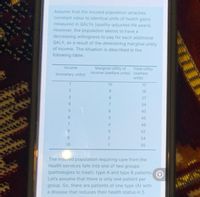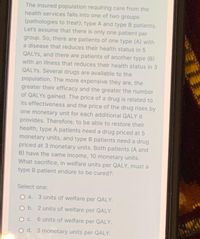
ENGR.ECONOMIC ANALYSIS
14th Edition
ISBN: 9780190931919
Author: NEWNAN
Publisher: Oxford University Press
expand_more
expand_more
format_list_bulleted
Concept explainers
Question

Transcribed Image Text:Assume that the insured population attaches
constant value to identical units of health gains
measured in QALYS (quality-adjusted life years).
However, the population seems to have a
decreasing willingness to pay for each additional
QALY, as a result of the diminishing marginal utility
of income. The situation is described in the
following table:
Income
Total utility
income (welfare units) (welfare
units)
Marginal utility of
(monetary units)
10
10
2
9.
19
3
8.
27
4.
34
40
45
7.
4.
49
8.
52
6.
54
10
55
The insured population requiring care from the
health services falls into one of two groups
(pathologies to treat): type A and type B patients,
Let's assume that there is only one patient per
group. So, there are patients of one type (A) with
a disease that reduces their health status in 5

Transcribed Image Text:The insured population requiring care from the
health services falls into one of two groups
(pathologies to treat): type A and type B patients.
Let's assume that there is only one patient per
group. So, there are patients of one type (A) with
a disease that reduces their health status in 5
QALYS, and there are patients of another type (B)
with an illness that reduces their health status in 3
QALYS. Several drugs are available to the
population. The more expensive they are, the
greater their efficacy and the greater the number
of QALYS gained. The price of a drug is related to
its effectiveness and the price of the drug rises by
one monetary unit for each additional QALY it
provides. Therefore, to be able to restore their
health, type A patients need a drug priced at 5
monetary units, and type B patients need a drug
priced at 3 monetary units. Both patients (A and
B) have the same income, 10 monetary units.
What sacrifice, in welfare units per QALY, must a
type B patient endure to be cured?:
Select one:
O a. 3 units of welfare per QALY.
O b. 2 units of welfare per QALY.
O C. 6 units of welfare per QALY.
O d. 3 monetary units per QALY.
Expert Solution
This question has been solved!
Explore an expertly crafted, step-by-step solution for a thorough understanding of key concepts.
Step by stepSolved in 2 steps

Knowledge Booster
Learn more about
Need a deep-dive on the concept behind this application? Look no further. Learn more about this topic, economics and related others by exploring similar questions and additional content below.Similar questions
- Access to health and a person’s health status play an important role in longevity and quality of life. As we have sadly learned in the pandemic, the majority of serious illnesses and deaths stem from lower income and certain minority groups. Please discuss your view of these important variables that impact our health system. Please remember to cite at least one source and clearly articulate your views (250 Words)arrow_forwardFind the derivative of the function. y= In(6x) Find the derivative of the function. y= In(x³) Find the derivative of the function. f(x) = In(8x+9) Find the derivative of the function. y= In(3x²-x)+6x Find difp In(+9). dq dp dq Find y' y=2x-In(8x) y' = Aarrow_forwardPlease answer both parts I do not understand. Thank you :) Part A: Suppose that there is a 20% chance Malik is injured and earns $100,000, and an 80% chance he stays healthy and will earn $500,000. Suppose further that his utility function is the following (utility = square root of income) Malik's expected income is _____. $550,000 $365,000 $400,000 $420,000 $500,000 Part B: Suppose that there is a 20% chance Malik is injured and earns $100,000, and an 80% chance he stays healthy and will earn $500,000. Suppose further that his utility function is the following (utility = square root of income) Malik's utility from his expected income is ____. Malik's expected utility of income is _____. 628.9; 648.1 604.2; 562.1 648.1; 628.9 562.1; 604.2arrow_forward
- Demand for medical services is price inelastic (Absolute value of price elasticity of demand is less than 1 and greater than zero). Medical services are different from most other goods and services in that the person who determines the demand (the patient) is not the person who makes the payment (payment is made by the insurance company). How does this affect the price elasticity of demand for medical services (increase it or decrease it)? You may assume that this question only refers to people who have health insurance. Ignore co-payments and deductibles and any other out-of-pocket expenses. Please give an explanation.arrow_forward** PRACTICE TEST **arrow_forwardUsing a basic illustration, explain your understanding of utility theory given uncertaintyarrow_forward
- Which statement about the individual health insurance market in the U.S. is correct? Question options: 1) Among the non-elderly with private health insurance, about one-third now purchase it in the individual market 2) Individual market enrollment increased with implementation of the Affordable Care Act in 2014, but it has declined in every year since 3) According to data from the Kaiser Family Foundation, On-Exchange enrollment has been roughly constant (varied by less than 1 million) since 2015 4) According to data from the Kaiser Family Foundation, Off-Exchange enrollment has grown relative to On-Exchange since 2015arrow_forwardSee attachment. Whats the the maximum health insurance premium the individual is willing to pay?arrow_forward
arrow_back_ios
arrow_forward_ios
Recommended textbooks for you

 Principles of Economics (12th Edition)EconomicsISBN:9780134078779Author:Karl E. Case, Ray C. Fair, Sharon E. OsterPublisher:PEARSON
Principles of Economics (12th Edition)EconomicsISBN:9780134078779Author:Karl E. Case, Ray C. Fair, Sharon E. OsterPublisher:PEARSON Engineering Economy (17th Edition)EconomicsISBN:9780134870069Author:William G. Sullivan, Elin M. Wicks, C. Patrick KoellingPublisher:PEARSON
Engineering Economy (17th Edition)EconomicsISBN:9780134870069Author:William G. Sullivan, Elin M. Wicks, C. Patrick KoellingPublisher:PEARSON Principles of Economics (MindTap Course List)EconomicsISBN:9781305585126Author:N. Gregory MankiwPublisher:Cengage Learning
Principles of Economics (MindTap Course List)EconomicsISBN:9781305585126Author:N. Gregory MankiwPublisher:Cengage Learning Managerial Economics: A Problem Solving ApproachEconomicsISBN:9781337106665Author:Luke M. Froeb, Brian T. McCann, Michael R. Ward, Mike ShorPublisher:Cengage Learning
Managerial Economics: A Problem Solving ApproachEconomicsISBN:9781337106665Author:Luke M. Froeb, Brian T. McCann, Michael R. Ward, Mike ShorPublisher:Cengage Learning Managerial Economics & Business Strategy (Mcgraw-...EconomicsISBN:9781259290619Author:Michael Baye, Jeff PrincePublisher:McGraw-Hill Education
Managerial Economics & Business Strategy (Mcgraw-...EconomicsISBN:9781259290619Author:Michael Baye, Jeff PrincePublisher:McGraw-Hill Education


Principles of Economics (12th Edition)
Economics
ISBN:9780134078779
Author:Karl E. Case, Ray C. Fair, Sharon E. Oster
Publisher:PEARSON

Engineering Economy (17th Edition)
Economics
ISBN:9780134870069
Author:William G. Sullivan, Elin M. Wicks, C. Patrick Koelling
Publisher:PEARSON

Principles of Economics (MindTap Course List)
Economics
ISBN:9781305585126
Author:N. Gregory Mankiw
Publisher:Cengage Learning

Managerial Economics: A Problem Solving Approach
Economics
ISBN:9781337106665
Author:Luke M. Froeb, Brian T. McCann, Michael R. Ward, Mike Shor
Publisher:Cengage Learning

Managerial Economics & Business Strategy (Mcgraw-...
Economics
ISBN:9781259290619
Author:Michael Baye, Jeff Prince
Publisher:McGraw-Hill Education